Opera Obsession!: Opera D/ORO’S Greatest Hits
|
The Serinus Report |
| Music Reviews |
|
Jason Serinus |
|
6 September 2002 |
Opera Obsession!: Opera D/ORO’S Greatest Hits – OPD-1001
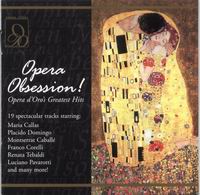 Attention, opera lovers and those who are trying to figure out why vocal fanatics go so nuts over certain singers. The beauty of some selections on this generous
Attention, opera lovers and those who are trying to figure out why vocal fanatics go so nuts over certain singers. The beauty of some selections on this generous
19-track, specially priced disc of excerpts from complete live opera recordings is so great that you will certainly want to add it to your collection.
Most of the singers on the list graced the stages of the Met and other major houses in the 60s and 70s. At the head of the list comes an incomparable 1969 performance from the great soprano Beverly Sills. The extended excerpt, “Il faut partir” from Donizetti’s La fille du régiment, conducted by Roland Gagnon, derives from OPD 1275, and also features Fernando Corena and Grayson Hirst. Sills is in radiant prime form. Her voice floats in air, the perfectly in tune, mesmerizing disembodied head tones for which she was prized heartbreaking in their tenderness. If you’re only familiar with Sills as a “personality” or spokesperson, this selection will prove a revelation; the woman was capable of magic.
Equally essential are two excerpts by the great soprano Montserrat Caballé. The first, “Oh nube! Che lieve” from Donizetti’s Maria Stuarda, recorded in Paris in 1972, derives from OPD 1315 conducted by Nello Santi. Caballé is in superb voice, freely spinning out her famed, silken soft pianissimo highs. The complete recording also features the voice of tenor José Carreras before it was compromised by singing too many heavy roles.
Even more heart-opening is Richard Strauss’ brief “Und du wurst mein…” fromArabella, in which Caballé joins Siegmund Nimsgern in phrases so meltingly lovely as to lead this listener to hit repeat many times over. Excerpted from OPD 1282, this live 1973 Rome performance, conducted by Wolfgang Rennert, also features René Kollo and Kurt Moll. Although Caballé made a highly praised commercial recording of Strauss’ Salome for RCA, she is not particularly known as a Strauss singer; her commercial recording of the Four Last Songs, for example, finds her out of her element, her usual manner of phrasing ill-suited to Strauss’ elongated, soaring lines. In this excerpt, at least, she is marvelous.
The remaining excerpts on this “who’s who” of opera greats from the last generation include Placido Domingo’s 1972, “Celeste Aida”; Renata Tebaldi’s 1960 “Ebben? Ne andrò lontana;” Renata Scotto and José Carreras living it up in a 1973 Tokyo “Libiamo;” Franco Corelli giving Pavarotti and crew a run for the money in a 1964 “Nessun Dorma” (excerpted from a tantalizing complete Turandot also starring Birgit Nilsson and Galina Vishnevskaha) and 1962 “Di quella pira,” (excerpted from the famed, oft-issued Salzburg Il trovatore in which von Karajan conducts a stunning cast that also includes Leontyne Price, Ettore Bastianini, and Giulietta Simionato; Freni freshly sighing “Mi chiamano Mimi” from a live Schippers-conducted La Bohèmeof 1969 that also features Pavarotti; Maria Callas and Giuseppe di Stefano dueting in a famed 1952 Mexico City Rigoletto; and Pavarotti solo in excerpts from a 1967 Luciaand 1969 Manon (in Italian). Kraus, Bergonzi, Janowitz, Gedda, and Vickers also contribute noteworthy solos.
Sound quality depends on whether the performance derives directly from the master tape or acetate, or from a CD copy of a CD copy of a filtered LP copy of a third generation tape. Regardless, for Sills and Caballé alone, the disc is not to be missed.
ITALIAN OPERA ARIAS: BELLINI – DONIZETTI – VERDI – PUCCINI – OLGA MAKARINA, SOPRANO – ROMEO RECORDS 7217
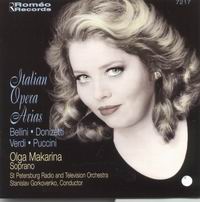 As Sills steps down as Chairperson of Lincoln Center, and Caballé resurfaces in Europe to offer glimmers of her fading gifts, the unfortunately named Olga Makarina, a student of definitely retired Renata Scotto who has sung at NYCO and the Met, delivers a debutrecital that could serve as a bid for the title of All-Purpose Soprano of the Decade. While she does not efface memories of others who have excelled in her chosen repertoire, Makarina offers solid, satisfying performances with a fine helping of vocal beauty.
As Sills steps down as Chairperson of Lincoln Center, and Caballé resurfaces in Europe to offer glimmers of her fading gifts, the unfortunately named Olga Makarina, a student of definitely retired Renata Scotto who has sung at NYCO and the Met, delivers a debutrecital that could serve as a bid for the title of All-Purpose Soprano of the Decade. While she does not efface memories of others who have excelled in her chosen repertoire, Makarina offers solid, satisfying performances with a fine helping of vocal beauty.
The soprano begins with “Eccomi in lieta vesta… O quante volte,” an exquisite recitative and aria from the first act of Bellini’s I Capuleti e I Montecci.” The voice is lovely, the retards sensible, the sentiment appropriate for conveying Juliette’s longing for her Romeo. Though the rendition lacks the poignancy and heart-shattering shimmer of Sills’ rare live 1968 Köln performance (last available on Arkadia GI 804.1), it remains the most satisfying performance on the disc.
The recital proceeds without surprises. The bright coloratura gem, “O luce di quest’anima” from the first act of Donizetti’s Linda di Chamounix, offers fine coloratura and a strong if only briefly held high E, but lacks the lightness, buoyancy, speed, and thrilling conclusion that Sills and Sutherland brought to this music. The aria and cabaletta from Act II of Verdi’s Luisa Miller demands a heavier voice and more interpretive nuance in the cabaletta; “Qui la voce sua soave…vien diletto” from Bellini’s I Puritani leaves Callas, Sutherland, and (way back) Olympia Boronat unchallenged; the Willow Song and Ave Maria from Verdi’s Otello, while quite beautiful, lack the last ounce of pathos necessary to make music so heartbreaking; and the “Casta Diva” from Bellini’s Norma leaves one praying, not to the goddess, but for Callas, Ponselle, or Gheorghiu (a soprano currently in her prime). Similar comments apply to the expected arias from Bellini’s La Sonnambula, and Verdi’s La Traviata; each lacks the ultimate brilliance and interpretive insight that separate the very good from the truly great.
Most disappointing are “Regnana nel silenzio…quando, rapito in estasi” from Donizetti’s Lucia di Lammermoor, which lacks the imagination and vocal magnificence that Sills (whose treasurable complete commercial recording has recently been reissued on Westminster 289 471 250-2) and Sutherland brought to the role; and an unidiomatic “O mio babbino caro” from Puccini’s Gianni Schicchi, which demands a fuller lower range and greater arching lyricism than Makarina provides.
Given the merely dutiful accompaniment provided by the St. Petersburg Radio and Television Orchestra conducted by Stanislav Gorkovenko, one wonders what Makarina can accomplish with a strong conductor such as Bonynge or Pappano. Coming later this year is an all-Mozart disc featuring “Exsultate, Jubilate,” three concert arias, and four arias from Don Giovanni and Le nozze di Figaro. Perhaps in Mozart’s far more classic vocal line, the soprano will truly shine.
THE COMEDY HARMONISTS: WHISTLE WHILE YOUR WORK – NAXOS 8.120613
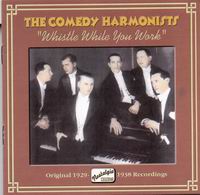 If ever there were reason to smile, the delightful all-male German vocal ensemble originally named The Comedian Harmonists provide justification aplenty. The slogan coined by the German recording industry of the 1930s, “The Comedian Harmonists Teach You To Laugh Again!” says it all.
If ever there were reason to smile, the delightful all-male German vocal ensemble originally named The Comedian Harmonists provide justification aplenty. The slogan coined by the German recording industry of the 1930s, “The Comedian Harmonists Teach You To Laugh Again!” says it all.
Thanks to Eberhard Fedner’s 1976 four-hour German television documentary on their work, Josef Vilsmaier’s 1998 biopic Harmonists, and the recent Naxos bargain-price remastering The Comedy Harmonists: Whistle While Your Work [Naxos 8.120613], which contains 19 original recordings made between 1929 and 1938, the Comedian Harmonists, later reconstituted as The Comedy Harmonists, live on.
From the first “Whistle While You Work” track on the Naxos disc, recorded in London in December, 1938 by what was then called The Comedy Harmonists, one cannot fail but be charmed by the group’s soft, impeccably tuned harmonies, delightfully accented English, chameleon-like imitation of instrumental sounds, good spirits, and infectious wit. Indeed, the ensemble’s members were so adept at singing, whistling, yodeling and imitating instruments that they made immensely successful, astoundingly realistic “all instrumental” vocal recordings of “Creole Love Call” and “The Barber of Seville – Overture.”
The idea to form what became Germany’s first “Boy-Group” originated with German comedian and student actor Harry Frommermann (1906-1975). While working in the USA in 1927 as Harry Frohman, the singer heard the Revelers, a male quartet whose style springs from the close harmonies of the minstrel and vaudeville traditions. After assimilating the Revelers’ style and drafting various vocal arrangements, Frommermann returned to Berlin.
In late December 1927, Frommermann put an ad in a Berlin newspaper looking for voices suitable for an ensemble. From many applicants he chose Robert Biberti (1902-1985), the son of a Berlin opera basso and a bass in the chorus line of the Charell-Revue. With the subsequent addition of Bulgarian high tenor Ari Leschnikoff (1897-1978), German second tenor Eric Abraham Collin (1899-1961), Polish baritone Josef Roman Cycowski (191-1998), and German pianist/arranger Erwin Bootz (1907-1982), The Comedian Harmonists quintet gave its first performances in 1928.
By 1929, when their second set of Odeon recordings was released, the Comedian Harmonists had become big draw, household names. They became so popular throughout Europe and the United States – they performed in Paris, Rome, Stockholm and New York – that they recorded over 150 titles and made at least thirteen pioneering talkie musicals (now lost) in the span of a few years.
Alas, by 1932, their music, with its American and Jewish influences, had already been blacklisted by Germany’s incoming National Socialist regime as “Jewish-Marxist noise.” In 1933, the Nazis declared three of the group’s Jewish members “non-Aryan.” Despite sell-out concerts, the group was banned in 1935 as “not in keeping with the cultural concepts of the Reich,” and the Jewish members, including Frommermann, were forced to leave the country. Miraculously, all survived.
The three “Aryan” Harmonists, however, remained in Berlin, acquired new members, and with Nazi permission reformed as “The Meistersextett – FORMERLY THE COMEDIAN HARMONISTS.” Restricted by the Nazis to performing non-humorous material written solely by Aryans, they achieved only modest success.
Meanwhile, in Vienna, the Jewish refugees recruited new members and formed The Comedy Harmonists. Moving their base of operations to Paris after the Nazi invasion of Austria, The Comedy Harmonists traveled throughout non-Nazi Europe, as well as to Argentina, Australia, New Zealand, South Africa and the US, including three days in San Francisco in 1939.
The Comedy Harmonists made a number of recordings, including some with Josephine Baker. Several of these, including treasurable English-language renditions of “Whistle While You Work,” “The Dwarf’s Yodel Song,” “Congo Lullaby,” and “The Donkey Serenade,” appear on the well-recorded Naxos disc.
Both groups disbanded in 1941, with members maintaining little or no contact with each other. Second tenor Erich Collin settled in Hawthorne, California. After working in a plastics factory, he formed The American Comedy Harmonists in the 1950s. Although the ensemble included Harry Frommermann, its duration was short. Baritone Josef Roman Cycowski, after losing much of his family in concentration camps, became Cantor in San Francisco’s Beth Israel Temple. Fommermann, who worked as a translator for the Allies in Nuremberg, became a New York cab driver, but eventually returned to Germany where he continued experimenting with singing harmony in his home studio.
You will be singing harmony as well once you hear this group’s marvelous recordings.
TWO RECENT RELEASES BY CLARINETIST RICHARD STOLTZMAN
Richard Stoltzman, currently touring around the United States, remains the foremost clarinetist of our time. His artistry, which marries a full, round, singing tone, flawless technique and innate musicality to a profound intellect and forward looking vision, has put him at the forefront of his field. Equally adept in classical and jazz idioms, he has received two Grammy awards and performed with over a hundred orchestras.
Stoltzman has established an ongoing program to commission new works for the clarinet. Nicholas Thorne, Timothy Greatbatch, Clare Fischer, Steve Reich, Toru Takemitsu, Lukas Foss, Stephan Hartke, and Einar Englund are among many who have written works for him.
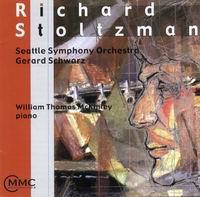 Two recently released CDs allow us to savor Stoltzman’s gifts. The first, Richard Stoltzman: Concertos for Clarinet and Orchestra [MMC2080], features Stoltzman and the Seattle Symphony conducted by Gerard Schwarz in four works written for Stoltzman between 1994 and 1998. The commissions are part of a joint project with the Seattle Symphony and the Warsaw Philharmonic, which has so far produced at least 40 concertos written for Stoltzman by American composers.
Two recently released CDs allow us to savor Stoltzman’s gifts. The first, Richard Stoltzman: Concertos for Clarinet and Orchestra [MMC2080], features Stoltzman and the Seattle Symphony conducted by Gerard Schwarz in four works written for Stoltzman between 1994 and 1998. The commissions are part of a joint project with the Seattle Symphony and the Warsaw Philharmonic, which has so far produced at least 40 concertos written for Stoltzman by American composers.
William Thomas McKinley’s Going Home is a 12-minute revisitation of the folk song “Going Home,” a tune that Dvorak employed symphonically. A one time around, unspliced improvisation featuring the composer at the piano, McKinley starts with the tune in symphonic form, and then moves into the realm of jazz improvisation; Schwarz brings the orchestra in when he feels appropriate.
In a phone interview, Stoltzman told me “Marie Barker Nelson knew that I liked to cook, especially pastries, so she came up with her Culinary Concerto for Orchestra based on taste sensations and cooking themes. It’s abstract – you don’t really pick up on [the culinary aspects] unless you read the titles of the four movements [Brothy Frothy, Sweet and Sour, Piquant, and Presto Zesto]. But when you do, it’s fun; I enjoyed doing it a lot.”
Jeffrey Nytch’s immensely enjoyable Concerto for Clarinet and Orchestra is based on a unique modal scale. Written in typical concerto form, its three movements are variously fast and exuberant, tender and heartfelt, and genuinely ebullient. Finally Margaret Brouwer’s eclectic 10-minute Concerto for Clarinet and Orchestra draws on her experience writing for dance groups. In the last movement, “he has the clarinet play a duet with a slide whistle using just the mouthpiece of the clarinet. There are also little jazz licks with the jazz player.
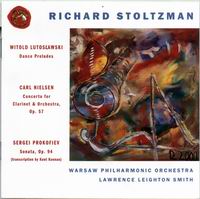 Richard Stoltzman: Lutoslawski – Nielsen – Prokofiev[BMG 09026-63836-2], backed by the Warsaw Philharmonic conducted by Lawrence Leighton Smith, features three 20th century works offering what Stoltzman calls “haunting and marvelous melodies” drawn from folklore traditions of the respected composers. Though BMG seems to have turned its back on most of its classical artists and catalogue, its disc boasts far more three dimensional sound and a seductively wider soundstage than the MMC CD.
Richard Stoltzman: Lutoslawski – Nielsen – Prokofiev[BMG 09026-63836-2], backed by the Warsaw Philharmonic conducted by Lawrence Leighton Smith, features three 20th century works offering what Stoltzman calls “haunting and marvelous melodies” drawn from folklore traditions of the respected composers. Though BMG seems to have turned its back on most of its classical artists and catalogue, its disc boasts far more three dimensional sound and a seductively wider soundstage than the MMC CD.
Witold Lutoslawski’s five short, sharply etched Dance Preludes for clarinet solo, percussion, harp, piano and strings were composed as his final farewell to his folk background. Carl Nielsen’s Concerto for Clarinet and Orchestra, Op. 57, on the other hand, is a major length work. “For clarinet players around the world,” says Stoltzman, “this is supposed to be the Holy Grail, the piece that if you ever get from the beginning to the end, you’re considered a martyr and bear stigmata afterwards and broken fingers and unbuttoned flies and hair that’s starting to fall out. It’s kind of a tough piece to play. I never, ever wanted to play it for a long time, until I finally decided that it was more than a series of technical problems and hurdles. It contains some very haunting and beautiful melodies, and I was gratified to finally record it before I died.”
The delightful Prokofiev Sonata, Op. 94 will be familiar to many listeners from its flute/piano and violin/piano scorings. Transcribed for clarinet and small orchestra by Kent Kennan, it’s a joy from start to finish.
GIACOMO PUCCINI – TOSCA – A REVIEW OF THE OPERA FILM AND CD RELEASE – [EMI CLASSICS 7243 5 57173 2 0]
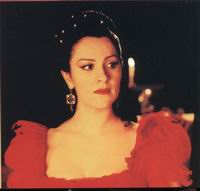 Opera films run the gamut from emotionally riveting to downright deadly. In the case of “Tosca,” the new film of Giacomo Puccini’s classic opera, there are sufficient emotional revelations, spiced with a few eyebrow-raising moments, to make the film both a must-see and a must-dish item for lovers of great singing and over-the-top melodrama.
Opera films run the gamut from emotionally riveting to downright deadly. In the case of “Tosca,” the new film of Giacomo Puccini’s classic opera, there are sufficient emotional revelations, spiced with a few eyebrow-raising moments, to make the film both a must-see and a must-dish item for lovers of great singing and over-the-top melodrama.
Directed and produced by the French team of Benoit Jacquot and Daniel Toscan du Plantier, the film, which has already been shown in New York and Los Angeles, arrives in Houston and San Francisco on August 30, moving on to Boston September 20, Coral Gables October 4, and Chicago October 18. The dubbed soundtrack derives from the complete EMI recording [7243 5 57173 2 0], a well-recorded, natural sounding, lavish undertaking filled with color shots from the movie, released last November.
The production spotlights the aurally and visually arresting talents of EMI Classics’ “love couple,” tenor Roberto Alagna and soprano Angela Gheorghiu. Of equal importance is the superb conducting of Antonio Pappano and the Orchestra of the Royal Opera House Covent Garden.
There are many pluses to this production. First and foremost, rather than trying to pretend that it is other than lip synched, the film makes the most of its synthetic nature by occasionally shifting between footage of the action, mostly shot in stunning color; black and white footage of the actual studio recording session, including many visually dramatic sweeps and gestures by conductor Pappano; and external shots of the imposing historic venues in which the action transpires. An especially brilliant use of color occurs in the final, pre-sunrise meeting between diva Tosca and her lover Cavaradossi; until the sun rises, the protagonists appear in black and white, with Tosca’s flaming red cape and her lover’s purple collar painted in. When the sun does rise, an appropriate change in orchestral accompaniment is matched by the return of full color cinematography.
Then, of course, there is the singing. Soprano Gheorghiu, undoubtedly one of if not the finest lyric/dramatic sopranos on today’s stage, delivers a fully nuanced portrayal as Tosca. The voice is at the peak of its beauty, inherently dramatic, seamless, and totally secure throughout the range.
For those accustomed to the unforgettable vocalism of Maria Callas in the title role – the 1953 monaural recording that remains one of the great operatic documents — Gheorghiu’s Act One love scene proves revelatory. Whereas the main emotions one feels from Callas are fire, jealousy, rage, and infinite variations thereof, Gheorghiu balances fury with a most seductive and convincing flirtatiousness. Though her Tosca does not burn with Callas’ red heat, her seductive, at time girlish interplay with her lover Cavaradossi, adds an extra dimension to her character.
The soprano’s offstage husband, Roberto Alagna, may be better suited for lighter French repertoire, but he manages his role quite well, offering sufficient subtlety without resorting to overacting to mostly hold his own with Gheorghiu’s vocalism. Most unfortunately, in a blatant attempt to beef up his voice, the filmmakers add far more reverberation than on the CD, making the tenor sound in a different acoustic environment than his partner. One second he’s at her side, the next sounding as if he’s singing from on high.
In other roles, veteran baritone Ruggero Raimondi is a fine Scarpia. Though he sounds a bit wooly, lacking the last ounce of venom that would make Scarpia sound as evil as his actions, his vocal portrayal by and large succeeds. Enrico Fissore as the Sacrestan is superb, voice and acting uniting to make his character’s weakness totally believable. Maurizio Muraro (Angelotti), David Cangelosi (Spoletta), and other supporting singers are vocally adequate for their roles, with boy soprano James Savage-Hanford quite lovely to hear and gaze upon.
Back to the acting. While Gheorghiu’s Act One portrayal is frequently revelatory, her histrionics in the two subsequent acts – my partner terms her a graduate of the “Jessye Norman School of Acting” – makes one thankful for Alagna’s reliance upon visual sincerity. Is this a case of Gheorghiu playing the diva Tosca, or of a soprano so convinced of her divahood that she too often plays herself playing Tosca (as Bette Davis, later in life, played Bette Davis playing whomever)? Both Gheorghiu and Raimondi frequently resort to ten changes of facial expression per minute… a good eight too many. Fissore, on the other hand, is as convincing a Sacrestan as one might ever wish to see. And if Cangelosi doesn’t make vocal waves as Spoletta, his pretty boy interplay with his master Scarpia, which includes the elder Chief of Police patting him sweetly on the cheek, adds a most intriguing undercurrent to the proceedings.
Finally, there is the conducting. Pappano understands the opera’s great swings of emotion, and has his players singing them with a heart and soul that consistently demonstrates Puccini’s orchestral mastery. Tosca may be a potboiler, but the musical direction is so generous, and the sweeps of orchestral color so seductive, that few will find themselves able to resist diving in.
![]()
Don’t forget to bookmark us! (CTRL-SHFT-D)
Stereo Times Masthead
Publisher/Founder
Clement Perry
Editor
Dave Thomas
Senior Editors
Frank Alles, Mike Girardi, Russell Lichter, Terry London, Moreno Mitchell, Paul Szabady, Bill Wells, Mike Wright, and Stephen Yan,
Current Contributors
David Abramson, Tim Barrall, Dave Allison, Ron Cook, Lewis Dardick, John Hoffman, Dan Secula, Don Shaulis, Greg Simmons, Eric Teh, Greg Voth, Richard Willie, Ed Van Winkle, Rob Dockery, Richard Doron, and Daveed Turek
Site Management Clement Perry
Ad Designer: Martin Perry





Be the first to comment on: Opera Obsession!: Opera D/ORO’S Greatest Hits